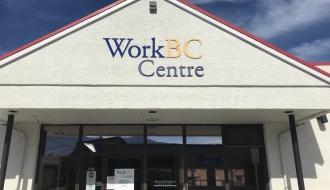Information Technology Training Offers Power and Possibilities

When the COVID-19 pandemic broke out, Ruby-Ann Hughan was a restaurant line cook in Prince George who saw her work disappear. Meanwhile, Sidney Wallace was searching for entry-level jobs as a cashier or warehouse worker in Vancouver. Neither was feeling excited about their prospects — until they learned about the Information Technology Technician Training Program.

“Taking this program was an opportunity of a lifetime,” says Ruby-Ann, who is also a member of the Haida Nation.
Sidney, a member of Tla'amin Nation, explains that, when a family member drew his attention to the program, “it seemed like an amazing opportunity — one in which [he] could learn and be trained in a new field.”
Funded by the Ministry of Post-Secondary Education and Future Skills , the IT Technician Training Program is a partnership between Total Support Solutions (TSS) and ACCESS (Aboriginal Community Career Employment Services Society). ACCESS provides a variety of employment and training programs and services to increase Indigenous participation in the labour market. TSS specializes in providing a range of computer and network maintenance services to Indigenous communities and organizations.
TSS had long used training to recruit employees into its company. CEO Chris Gillen says the skills training funding allowed TSS to work with ACCESS to create a six-month program that prepares graduates to enter the workforce as Computing Technology Industry Association certified Level 1 technicians.
ACCESS provides fundamental skills training that helps prepare participants for the modern workplace — especially self-discipline, which is important while learning and working remotely. ACCESS also provides students with less tangible support to help them believe in themselves as they tackle a brand-new challenge.
“ACCESS helped me find confidence, and that's something I will take with me for the future,” explains Ruby-Ann. “It was a huge leap to do something different and I was afraid of change. I really appreciate Cynthia [Edwards, Student Support Coach] reaching out to me often to check in and reassure me. It was amazing to have a team of people cheering me on and helping me find success.”

Sidney cites the preparation offered by ACCESS as a factor in his success, along with the welcoming learning environment and job shadowing offered by TSS. However, he notes that the financial support offered to students throughout the training period made it possible to enter the program in the first place.
“Without it, I wasn't sure I could put aside everything for months in order to take this course,” he adds. “I certainly wouldn't have been able to put the effort I did into it.”
TSS provides a remote classroom that offers a safe and supportive environment where students learn about general computer skills, hardware troubleshooting, software, networking and cyber security. The company also provides co-op work opportunities for each student to prepare them to enter the workforce — either as an employee or as a self-employed contractor.
“The job market is very good — there is constant and continuous demand,” explains Chris.
He says when the pandemic occurred, information technology became an essential service as employers scrambled to accommodate remote work environments. He hopes organizations will continue to embrace remote work well after the pandemic ends.
“I have long argued that geography should not be a limiter to opportunity,” he says. “Working from home allows employers to pull from a much larger talent pool. Talent should be the determinant, not where you live.”
Chris notes that remote IT training and working conditions allow Indigenous IT technicians to continue to live and work in their communities.
In total, eight participants completed the program in 2021. Chris says he hopes the program continues because it allows people out of high school to rapidly transition into the work force while acquiring a flexible set of skills. Ruby-Ann, who is now employed by Total Support Solutions, says she hopes to go on to become a Level 2 technician and then explore leadership opportunities in the future. And yet, Chris says the options offered by the IT training program go beyond even that.
“Students can use the training to understand not just how IT works, but how to think your way through a problem. Because, ultimately, that’s what we’re teaching: problem solving. And I think there’s real power in that.”
Technology continues to be a growing sector with a wide variety of jobs and career opportunities. Learn more about this industry, including available jobs here.
The Ministry of Post-Secondary Education and Future Skills has invested $15 million to help Indigenous communities manage the economic impacts of COVID-19. The skills training funding goes to Indigenous training partners throughout B.C. to address COVID-19 recovery in the workforce.






